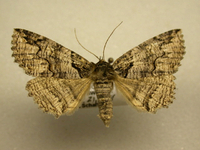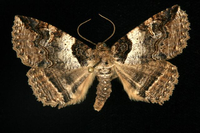| Species Status: This distinctive Zale has long been thought to represent a complex of two forms, recognized previously as subspecies by Forbes (1954) and described more recently as two distinct species by Schmidt (2010). Forbes believed that the name lunifera should be restricted to the southern form, with subspecies woodii used for the form found in the northern part of its range. Schimdt agreed with this description but applied a new name, Zale intenta, to the more widespread populations located in the north, leaving lunifera as the name for populations located east and south of the Appalachians.
Forbes distinguished the two based on differences in maculation, with the southern form possessing more irregular lines and striations and a stronger and more deeply dentate subterminal line. In addition to differences in pattern, however, Schmidt reported genetic differences, as well as differences in size and the degree of elongation of their wings. Several of these characters appear to be more clearly distinct in the Northeast. In North Carolina, specimens that have been bar-coded as Z. intenta appear to be smaller than those bar-coded as Z. lunifera, which is the opposite of what Schmidt reported. Other morphological characters that were reported to be diagnostic often exhibit varying levels of discordance in local and regional populations and do not appear to be diagnostic for many North Carolina specimens. In the Northeast, Z. intenta is widespread and believed to feed primarily on cherries (Prunus spp.), whereas Z. lunifera is confined to sandy pine barrens where it feeds on scrub oaks, including Bear Oak (Q. ilicifolia). The pattern of host use has not been clearly established in the Southeast, including North Carolina.
Schmidt's work is somewhat difficult to interpret due to the fact that it lacks illustrations of the genitalia, does not include a detailed genetic analysis of the findings, and only includes the mean values for sizes that, in turn, were based on very small sample sizes. DNA barcoding indicate that genetic differences between these forms is relatively slight (currently comprising a single BIN), and well below the 2% difference that is often used as a general signal of pairs constituting distinct species. The status of populations in the south appears to be particularly uncertain. Schmidt stated that surveys are especially needed in the Appalachians and Coastal Plain from New Jersey southward. Based on these uncertainties, we have provisionally elected to refer to North Carolina specimens as Z. lunifera (sensu lato). Hopefully a more comprehensive study of these forms will be conducted in the future to provide clarity as to the presence of intenta in the south, along with the taxonomic status of Z. intenta overall. |

 »
»




 »
»


